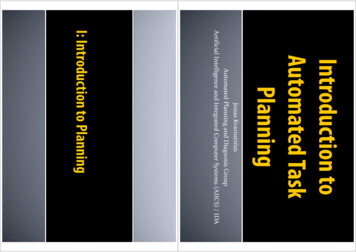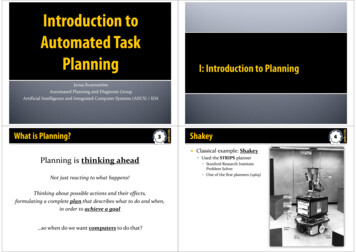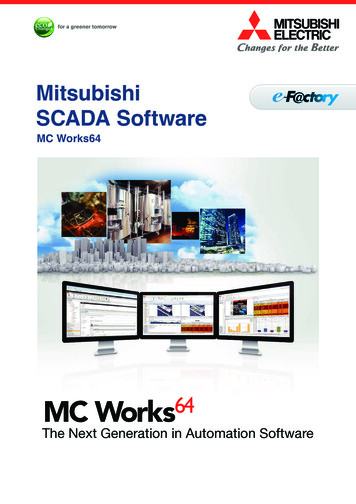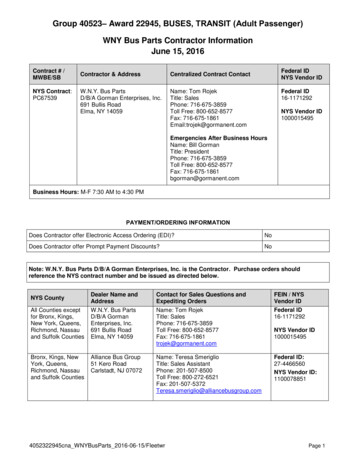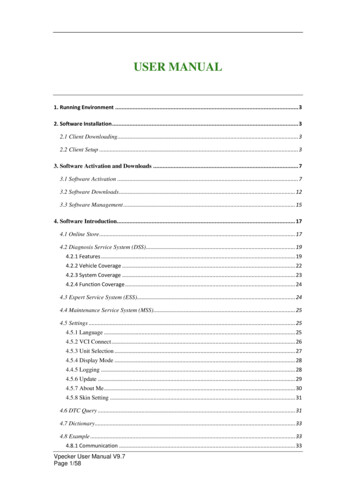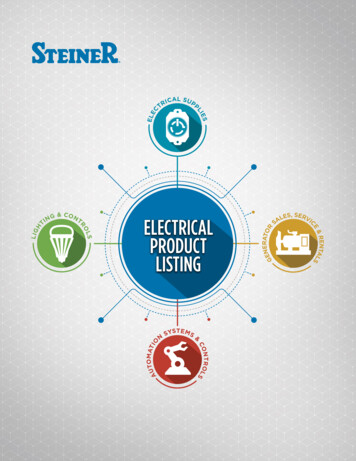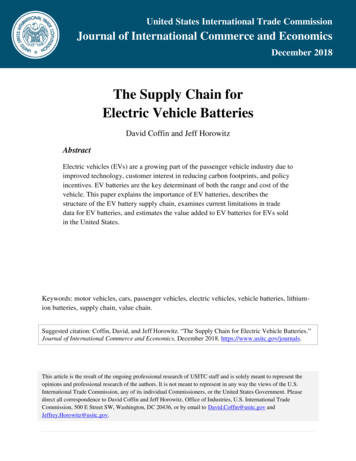
Transcription
PASSENGER ELEVATORS
Utilizing its technological prowess and extensive experience, we have remaineda leader in the vertical transportation market since entering the business in 1931.The Company’s creative, innovative spirit, represented by production of theworld’s first spiral escalator and elevator group-control systems that use artificialintelligence technologies, continues to receive high evaluations industry-wide.Our products and systems are renowned for their high levels of quality, reliabilityand safety; and it is this sense of security and trust fostered with building ownersand end-users alike that has led to the global expansion of our elevator/escalatorbusiness and the after-sales network to service it.We understand responsibilities as a good corporate citizen, and continue to implement measures for protecting the environment and ensuring a sustainable societyfor future generations. A number of original technologies are being introduced toensure more efficient products, systems and manufacturing operations, therebyenhancing productivity, reducing energy consumption and providing smoother,faster and more comfortable vertical transportation systems.12
PrincipleContentsBased on our policy, “Quality in Motion”,Introduction5–6Ecology7–8we provide elevators and escalators that willsatisfy our customers with high levels ofcomfort, efficiency, ecology and safety.9–11Efficiency12–14Safety and Comfort15Standard DesignFeatures16–18Basic Specifications19–2425Important Information on Elevator tsubishi Electric Standard1.51.0Our elevators, escalators and building management systems are always evolving,helping achieve our goal of being the No.1 brand in quality.In order to satisfy customers in all aspects of comfort, efficiency and safety whilerealizing a sustainable society, quality must be of the highest level in all productsand business activities, while priority is place on consideration for the environment.As the times change, we promise to utilize the collective strengths of its advancedand environmental technologies to offer its customers safe and reliable productswhile contributing to society.0.75450550 . . . . . . . . . . . . 750 . . . . . . . . . . . . . . . . . . . . . . . . . . . . . . . . . . . . . . . . . . . .75825 . . . . . . . . . . . . . . . . . . . . . . . . . . . 1350We strive to be green in all ofour business activities.We take every action to reduce environmentalburden during each process of our elevators’and escalators’ 881.00.75750 . . . . . . . . . . . . . . . . . . . . . . . . . . . . . . . . . . 1350(kg)* Quality in Motion is a trademark of Mitsubishi Electric Corporation.34
Welcome to a New Era in Vertical TransportationIntroducing the NEXIEZ.5 technologically advanced elevators that consume less power,have minimal impact on the global environment and harmoniously serve people and buildings with smooth,seamless operation. The refined design produces a high-quality atmosphere that reassures passengers of thesuperior safety and comfort synonymous with our products. Regardless of the use or purpose, the NEXIEZ is abest match solution for virtually any elevator installation.6
Reusing EnergyEnhancing Energy EfficiencyRegenerative Converter: PCNV (Optional)Traction Machine with PM MotorElevators usually travel using power from a power supply (poweredoperation); however, when they travel down with a heavy car loador up with a light car load (regenerative operation), the tractionmachine functions as a power generator. Although the powergenerated during traction machine operation is usually dissipatedas heat, the regenerative converter transmits the power back to thedistribution transformer and feeds into the electrical network in thebuilding along with electricity from the power supply. Comparedto the same type of elevator without a regenerative converter, thissystem provides an energy-saving effect of approximately 35%.*In addition, the Regenerative Converter has the effect of decreasingharmonic currents.(PM motor: Permanent magnet motor)Note: * The value is a reference datum and may increase or decrease inaccordance with actual conditions of use and elevator ansformerControl panelRegenerativeconverterControl panelMotorMotorDistributiontransformerPower supplyGearless tractionmachine with PM motorPower supplyRegenerative operationPowered operationEcologyThe joint-lapped core builtin the PM motor of thetraction machine featuresflexible joints. The iron corecan be like a hinge, whichallows coils to be woundaround the core moredensely, resulting inimproved motor efficiencyand compactness.High-density magnetic fieldis produced, enabling loweruse of energy and resourcesand reduced CO2 emissions.In addition, we haveadopted a 2:1 (single-wrap)roping system, whichlessens load on the tractionmachine, and allows furtherreductions in tractionmachine size.Devices that Use Less EnergyLED Lighting (Optional)Using Energy WiselyEnergy-efficient LEDs consume less power than conventional lamps. Used forceiling lights and hall lanterns, LEDs boost the overall energy performance ofthe building. Furthermore, the long service life eliminates the need forfrequent lamp replacement.Our long-term commitment to developing energy-efficient elevators has created systems and functions that makeintelligent use of power. Advantage of LEDsMilestones of Energy-saving Technologies in Elevator DevelopmentService life (hr)Traction machineAC2 controlAC V V *1Notes:*1: Alternative current, variable voltage*2: Variable voltage, variable frequency*3: CO2 emissions in this table are from elevatoroperation and do not include emissions frommanufacturing, transportation and other EDIncandescentlamp132Approximately 75% reductionCeiling: L210S LED downlights (yellow-orange)*2V V V F co n t r o lEnergy-saving FeaturesMicrocomputer93%Power consumption (W)Approximately 12.5 times longerG e a r l e ssRelay100%LEDt m o to rPermanent magneWorm gearedControl circuitPower consumption /CO2 emissions *320 0 0I n d u c t i o n m o to rMotorMotor drive1990198019702010Ceiling: L210S37%30 %Approx.–70%We offer features that help to reduce the energy consumption of elevators.Energy-saving Operation – Number of Cars: ESO-N (Optional for ΣAI-22)The number of service cars is automatically reduced to some extent without affecting passenger waiting time.Energy-saving Operation – Allocation Control: ESO-W (ΣAI-2200C only)Based on each elevator’s potential energy consumption, the system selects the elevator that best balances operationalefficiency and energy consumption. Please refer to page 10 for details.Car Light/Fan Shut Off – Automatic: CFO-A/CLO-AThe car lighting/ventilation fan is automatically turned off if there are no calls for a specified period.78
EfficiencyForecasting a Near-Future Hall Call to Reduce Long WaitsSmooth Mobility through Efficient Group ControlWhen a building is expected to have heavy traffic, optimum car allocation suited for every conditionmakes a big difference in preventing congestion at a lobby floor and reducing long waits.Group Control Systems: ΣAI-22 and ΣAI-2200CΣAI-22 and ΣAI-2200C control multiple elevatorsoptimally according to the building size.Improving of traffic efficiency can alleviate thepassengers’ irritation. Applying the new allocationalgorithm, the average waiting time and long waitsare reduced.AI-2200C PerformanceGroup controlsystemsSuitable building sizeNumber of carsin a groupΣAI-22 systemSmall to medium3 to 4 carsΣAI-2200C systemLarge(Especially buildingswith dynamic trafficconditions)AI-2100NAverage Waiting TimeCooperative Optimization Assignment (ΣAI-2200C)When a hall call is registered, the algorithm assumes a near-future call that could require long waits. Through evaluationof the registered hall call and the forecasted call, the best car is assigned. All cars work cooperatively for optimum operation.CarCar callHall callTraveling directionEle. No.Ele. No.AI-2200C (latest)Long-Wait Rate(sec)30(%)10258206153 to 8 cars410250Morningup peakDaytime LunchtimeEveningdown peak0Improved: Max. 40%Morningup peakDaytime LunchtimeEveningdown peakImproved: Max. 80%Note: Simulated with 6 cars, 20 persons each at 2.5m/sec for 15 stops.AI-2100N[A hall call is registered at 6th Fl.]Allocates the closest car B.[Another hall call is soon registered at 11th Fl.]Allocates D, resulting in long wait of 26 sec.ΣAI-2200C (latest)[A hall call is registered at 6th Fl.]Allocates D, which is moving upward.[Another hall call is soon registered at 11th Fl.]Allocates B, which immediately arrives at the floor.Maximizing Operational Efficiency and Minimizing Energy ConsumptionEnergy-saving Operation — Allocation Control: ESO-W (ΣAI-2200C)This system selects the elevator in a group that best balances operational efficiency and energy consumption. Priorityis given to operational efficiency during peak hours and energy efficiency during non-peak hours.Car allocation that maximizes operational efficiency does not necessarily translate to energy efficiency.A car uses energy efficiently when it travels down with a heavy load, or up with a light load. Accordingly, if multiplecars have the same traveling distance, this system chooses the car that requires the least energy.Through a maximum 10% reduction in energy consumption compared to our conventional system, this system allowsbuilding owners to cut energy costs without sacrificing passenger convenience.Ele. No.9875432Initial conditions: non-peak periodCar A: Parked at the 3rd floorCar B: About to leave the 9th floor with several passengersCar C: Parked at the 9th floor.Car D: Parked at the 1st floorUnder the conditions above, when a hall call is registered at the 6th floor to go to the 1st floor,waiting time and traveling distance will be the same regardless of whether car A, B or C respondsto the call.In response to the call, the cars will operate in the following ways:Car A will travel up with no passengers and then down with only one passenger (requires more energy than car B).Car B will travel down with more passengers than car A (requires the least energy).Car C will travel down with no passengers and then down with only one passenger (requires the most energy).Car selectionDuring non-peak hours when energy efficiency is prioritized, car B is selected.1910
Safety and ComfortEfficiencySelecting Optimum Car Allocation through Rule-set SimulationsProviding a Safe, Comfortable RideDynamic Rule-set Optimizer (ΣAI-2200C)Based on real traffic data, passenger traffic is predicted every few minutes. According to the prediction, real-timesimulation selects the best rule-set (multiple rules have been set as car allocation patterns), which optimizes transportefficiency.Whether the user is elderly or a person with special need,our elevators deliver every passenger to the destinationfloor safely and comfortably.Allocating Passengers to Cars Depending on Destination FloorsDestination Oriented Allocation System: DOAS (Optional for ΣAI-2200C)When a passenger enters a destination floor at a hall, the hall operating panel immediately indicates which car will servethe floor. Because the destination floor is already registered, the passenger does not need to press a button in the car.Furthermore, dispersing passengers by destination prevents congestion in cars and minimizes their waiting andtraveling time.Standard arrangement of hall fixtures (No hall lantern* is provided.)Cars receive destination information from all floors to provide the best service for more complex traffic conditions throughout the day.Example of hall arrangementNote:* Hall lanterns are available as optional.The features introduced on these pages are applicable to ΣAI-2200C only. Please refer to page 17 and 18, and the ΣAI-2200C brochure for other features and details.1112
Safety and ComfortEmergency SituationsFor Comfortable UseEmergency operations*User-oriented DesignEnhance safety by adding emergency operation features which quickly respond to a power failure, fire or earthquake.Great care is taken in the design and manufacture of each and every elevator part to ensure a comfortable,user-friendly ride.Mitsubishi Emergency Landing Device: MELD (Optional)Upon power failure, a car automatically moves to the nearest floor using a rechargeablebattery to facilitate the safe evacuation of passengers.Power failureThe font for indicators and buttons is highly visible. On tactile buttons in particular, the font makes letters/numberseasy for visually-impaired passengers to distinguish.Operation by Emergency Power Source — Automatic/Manual: OEPS (Optional)Upon power failure, predetermined car(s) use a building’s emergency power supply to move to aspecified floor and open the doors for passengers to evacuate. After all cars have arrived,predetermined car(s) will resume normal operation.Fire Emergency Return: FER (Optional)FireClear FontWhen a key switch or a building’s fire sensors are activated, all cars immediately return to aspecified floor and open the doors to facilitate the safe evacuation of passengers.I234567890LCD Position Indicators: Car/hall (Optional)Clear, bright LCD indicators deliver information clearly and effectively.Indication examplesFirefighters’ Emergency Operation: FE (Optional)When the fire operation switch is activated, the car immediately returns to a predetermined floor.The car then responds only to car calls which facilitate fire-fighting and rescue operations.NormaloperationEarthquake Emergency Return: EER-P/EER-S (Optional)EarthquakeWhen a primary and/or secondary wave seismic sensor is activated, all cars stop at the nearestfloor and park there with the doors open to facilitate the safe evacuation of passengers.(HID-S)EmergencyoperationNote:* Please refer to page 16 for details.For Safe BoardingDoor safety devices(CID-S)Our reliable safety device ensures that the doors are clear to open and close. Depending on the type of sensor,the detection area differs.LCD Information Display*: 10.4- or 15-inch, for car/hall (Optional)The cutting-edge LCD display delivers elevator information with stereoscopic direction arrows and animated pictures.ColorsSelect the best color from our five popular andeye-catching background colors.Hall Motion Sensor: HMS(Optional)Multi-beam Door Sensor(Optional)Fine GreenModern WhiteElegance BrownUrban black* Please consult our local agents for the production terms, etc.13Stylish Blue14
Standard DesignFeatures (1/2)CarCar operating panelCeiling: S00FeatureFor front return panelYellow-orange lightingTactile buttonSUS-HLSUS-HLSUS-HLSUS-HLAluminumPR803 : GrayCBV1-C760CBV1-C760Ceiling: Painted steel sheet (Y033)with a milky white resin lighting coverLighting: Central lightingHall*1Segment LED indicators *2Tactile button with yellow-orange lighting1C to 2C 3C to 4C 3C to 8C2BCΣAI-22 ΣAI-2200C EMERGENCY OPERATIONS AND FEATURESBuilding ManagementSystem —GateWayBMS-GWEach elevator‘s status and operation can be monitored and controlled using a buildingmanagement system which manages various facilities in the building via the interface for theelevator system.Earthquake EmergencyReturnEER-PEER-SUpon activation of primary and/or secondary wave seismic sensors, all cars stop at the nearestfloor, and park there with the doors open to facilitate the safe evacuation of passengers.Emergency Car LightingECLCar lighting which turns on immediately when power fails, providing a minimum level oflighting within the car. (Choice of dry-cell battery or trickle-charge battery.)Fire Emergency ReturnFERUpon activation of a key switch or a building‘s fire alarm, all calls are canceled, all carsimmediately return to a specified evacuation floor and the doors open to facilitate the safeevacuation of passengers.Firefighters’ EmergencyOperationFEDuring a fire, when the fire operation switch is activated, the car calls of a specified car andall hall calls are canceled and the car immediately returns to a predetermined floor. The carthen responds only to car calls which facilitate fire-fighting and rescue operation.MelEyeMitsubishi Elevators &Escalators Monitoring andControl SystemWP-WEach elevator’s status and operation can be monitored and controlled using an advancedWebbased technology which provides an interface through personal computers. Specialoptional features such as preparation of traffic statistics and analysis are also available.Mitsubishi EmergencyLanding DeviceMELDUpon power failure, a car equipped with this function automatically moves and stops at thenearest floor using a rechargeable battery, and the doors open to facilitate the safeevacuation of passengers. (Maximum allowable floor-to-floor distance is 11 meters.)Operation by EmergencyPower Source —Automatic/ManualOEPSUpon power failure, predetermined car(s) uses the building’s emergency power supply tomove to a specified floor, where the doors then open to facilitate the safe evacuation ofpassengers. After all cars have arrived, the predetermined car(s) resume normal operation.Supervisory PanelWPEach elevator’s status and operation can be remotely monitored and controlled through apanel installed in a building's supervisory room, etc.Automatic Door-openTime AdjustmentDOTThe time doors are open will automatically be adjusted depending on whether the stop wascalled from the hall or the car, to allow smooth boarding of passengers or loading ofbaggage.Automatic Door SpeedControlDSACDoor load on each floor, which can depend on the type of hall doors, is monitored to adjustthe door speed, thereby making the door speed consistent throughout all floors.Door Load DetectorDLDWhen excessive door load has been detected while opening or closing, the doorsimmediately reverse.Door Nudging Feature —With BuzzerNDGA buzzer sounds and the doors slowly close when they have remained open for longer thanthe preset period. With the AAN-B or AAN-G feature, a beep and voice guidance soundinstead of the buzzer.DODAFailure of non-contact door sensors is checked automatically, and if a problem is diagnosed,the door-close timing is delayed and the closing speed is reduced to maintain elevatorservice and ensure passenger safety.Door SensorSelf-diagnosisHall position indicators and buttonsNarrow Jamb: E-102With plastic caseElectronic DoormanEDMDoor open time is minimized using the SR or Multi-beam Door Sensor feature that detectspassengers boarding or exiting.Extended Door-openButtonDKO-TBWhen the button inside a car is pressed, the doors will remain open longer to allow loadingand unloading of baggage, a stretcher, etc.HMSInfrared-light is used to scan a 3D area near the open doors to detect passengers or objects.Hall Motion SensorMulti-beam Door Sensor—Reopen with Hall ButtonROHB#1Hall Design ExampleSUS-HLJambSUS-HLDoorsHall position indicatorand buttonPIV1-A1010NNotes:*1: Maximum number of floors: 22 floors*2: Some letters of the alphabets are not available. Please consult our local agents for sMultiple infrared-light beams cover some height of the doors to detect passengers orobjects as the doors close. (Cannot be combined with the SR feature.)Closing doors can be reopened by pressing the hall button corresponding to the travelingdirection of the car.Repeated Door-closeRDCShould an obstacle prevent the doors from closing, the doors will repeatedly open andclose until the obstacle is cleared from the doorway.Safety Door EdgeSDEThe sensitive door edge detects passengers or objects during door closing.Safety Ray15Description DOOR OPERATION FEATURESCar Design ExampleWallsTransom panelDoorsFront return panelsKickplateFlooringCar operating panelAbbreviationSR1-beam2-beamOne or two infrared-light beams cover the full width of the doors as they close todetect passengers or objects. (Cannot be combined with the Multi-beam DoorSensor feature.)Notes: 1C-2BC (1-car selective collective) - Standard, 2C-2BC (2-car group control system) - Optional,ΣAI-22 (3- to 4-car group control system) - Optional, ΣAI-2200C (3- to 8-car group control system) - Optional Standard Optional Not applicable to 1C-2BC Not applicable#1: Please consult our local agents for the production terms, etc.Segment LED indicators *2Tactile button with yellow-orange lightingActual colors may differ slightly from those shown.Please refer to the design guide for details and other designs.16
Features (2/2)FeatureAbbreviationDescription1C to 2C 3C to 4C 3C to 8C2BCΣAI-22 ΣAI-2200C OPERATIONAL AND SERVICE FEATURESExclusive operation where an elevator can be operated using the buttons and switches located inthe car operating panel, allowing smooth boarding of passengers or loading of baggage.FeatureAbbreviationDescriptionDown Peak ServiceDPSControls the number of cars to be allocated and the timing of car allocation in order to meetincreased demands for downward travel during office leaving time, hotel check-out time, etc.to minimize passenger waiting time.Elevator Call Systemwith SmartphoneELCS-SPAttendant ServiceASAutomatic BypassABPA fully-loaded car bypasses hall calls in order to maintain maximum operational efficiency.Automatic Hall CallRegistrationFSATIf one car cannot carry all waiting passengers because it is full, another car will automaticallybe assigned for the remaining passengers.Energy-saving Operation —Number of CarsBackup Operation forGroup Control MicroprocessorGCBKAn operation by car controllers which automatically maintains elevator operation in theevent that a microprocessor or transmission line in the group controller has failed.#3ESO-NTo save energy, the number of service cars is automatically reduced to some extent, but notso much that it adversely affects passenger waiting time.Forced Floor StopFFSAll cars in a bank automatically make a stop at a predetermined floor on every trip withoutbeing called.Intense Up PeakIUPTo maximize transport efficiency, an elevator bank is divided into two groups of cars to serveupper and lower floors separately during up peak. In addition, the number of cars to beallocated, the timing of car allocation to the lobby floor, the timing of door closing, etc. arecontrolled based on predicted traffic data.UCPSWhen traffic is light, empty or lightly-loaded cars are given higher priority to respond to hall callsin order to minimize passenger travel time. (Cannot be combined with hall position indicators.)Lunchtime ServiceLTSDuring the first half of lunchtime, calls for a restaurant floor are served with higher priority, andduring the latter half, the number of cars allocated to the restaurant floor, the allocation timingfor each car and the door opening and closing timing are all controlled based on predicted data.Main Floor ChangeoverOperationTFSThis feature is effective for buildings with two main (lobby) floors. The floor designated as the“main floor” in a group control operation can be changed as necessary using a manual switch.Main Floor ParkingMFPAn available car always parks on the main (lobby) floor with the doors open (or closed onlyin China).#2#2Car Call CancelingCCCWhen a car has responded to the final car call in one direction, the system regards remainingcalls in the other direction as mistakes and clears them from the memory.Car Fan Shut Off —AutomaticCFO-AIf there are no calls for a specified period, the car ventilation fan will automatically turn off toconserve energy.Car Light Shut Off —AutomaticCLO-AIf there are no calls for a specified period, the car lighting will automatically turn off toconserve energy.Continuity of ServiceCOSA car which is experiencing trouble is automatically withdrawn from group control operationto maintain overall group performance.Elevator and SecuritySystem InterfaceEL-SCAEL-SCPersonal authentication by building‘s security devices can trigger predetermined elevatoroperation such as permission of access to private floors, automatic registration of a hall call and adestination floor, and priority service.False Call Canceling —AutomaticFCC-AIf the number of registered car calls does not correspond to the car load, all calls arecanceled to avoid unnecessary stops.Special Car Priority ServiceSCPSSpecial cars, such as observation elevators and elevators with basement service, are givenhigher priority to respond to hall calls. (Cannot be combined with hall position indicators.)#2False Call Canceling —Car Button TypeIf a wrong car button is pressed, it can be canceled by quickly pressing the same buttonagain twice.Special Floor Priority ServiceSFPSSpecial floors, such as floors with VIP rooms or executive rooms, are given higher priority for carallocation when a call is made on those floors. (Cannot be combined with hall position indicators.)#2FCC-PUp Peak ServiceUPSControls the number of cars to be allocated to the lobby floor, as well as the car allocationtiming, in order to meet increased demands for upward travel from the lobby floor duringoffice starting time, hotel check-in time, etc., and minimize passenger waiting time.VIP OperationVIP-SA specified car is withdrawn from group control operation for VIP service operation. Whenactivated, the car responds only to existing car calls, moves to a specified floor and parksthere with the doors open. The car then responds only to car calls.Independent ServiceINDExclusive operation where a car is withdrawn from group control operation for independentuse, such as maintenance or repair, and responds only to car calls.Next LandingNXLIf the elevator doors do not open fully at a destination floor, the doors close, and the carautomatically moves to the next or nearest floor where the doors open.Non-service to SpecificFloors —Car Button TypeNS-CBNon-service to SpecificFloors —Switch/Timer TypeNSNS-TNon-service TemporaryRelease for Car Call —Card Reader TypeNSCR-COut-of-service by Hall KeySwitchHOSHOS-TTo enhance security, service to specific floors can be disabled using a manual or timerswitch. This function is automatically deactivated during emergency operation.Overload Holding StopOLHA buzzer sounds to alert the passengers that the car is overloaded. The doors remain openand the car will not leave that floor until enough passengers exit the car.Auxiliary Car OperatingPanel#1Basic AnnouncementCar Arrival ChimeCar Information DisplayCar LCD Position IndicatorFor energy conservation, power regenerated by a traction machine can be used by otherelectrical systems in the building.Return OperationRETUsing a key switch on the supervisory panel, a car can be withdrawn from group controloperation and called to a specified floor. The car will park on that floor with the doors open,and not accept any calls until independent operations begin.Safe LandingSFLIf a car has stopped between floors due to some equipment malfunction, the controllerchecks the cause, and if it is considered safe to move the car, the car will move to thenearest floor at a low speed and the doors will open.SCS-BTo enhance security, car calls for desired floors can be registered only by entering secretcodes using the car buttons on the car operating panel. This function is automaticallydeactivated during emergency operation.ACSAAN-BAECC (car)AECH (hall)CIDCID-SClosest-car PriorityServiceCongested-floor ServiceDestination OrientedAllocation SystemBSOCNPSHall buttons and the cars called by each button can be divided into several groups forindependent group control operation to serve special needs or different floors.A function to give priority allocation to the car closest to the floor where a hall call buttonhas been pressed, or to reverse the closing doors of the car closest to the pressed hall callbutton on that floor. (Cannot be combined with hall position indicators.)CFSThe timing of car allocation and the number of cars to be allocated to floors where meetingrooms or ballrooms exist and the traffic intensifies for short periods of time are controlledaccording to the detected traffic density data for those floors.DOASWhen a passenger enters a destination floor at a hall, the hall operating panel indicateswhich car will serve the floor. The passenger does not need to press a button in the car.Dispersing passengers by destination prevents congestion in the cars and minimizes waitingand traveling time.#2, #2, #2#2A synthetic voice (and/or buzzer) alerts passengers inside a car that elevator operation has beentemporarily interrupted by overloading or a similar cause. (Available in limited languages.)Electronic chimes sound to indicate that a car will soon arrive. (The chimes are mountedeither on Car Arrival Chime the top and bottom of the car, or in each hall.)This 10.4- or 15-inch LCD for car front return panels shows the date and time, car position,travel direction and elevator status messages.* Please consult our local agents if you would like to display a video or a slideshow of still imageson the screen.This 5.7-inch LCD for car operating panels shows the date and time, car position, traveldirection and elevator status messages.FHLA hall lantern, which corresponds to a car’s service direction, flashes to indicate that the carwill soon arrive.Hall Information DisplayHIDThis 10.4- or 15-inch LCD for elevator halls shows the date and time, car position, traveldirection and elevator status messages.* Please consult our local agents if you would like to display a video or a slideshow of still imageson the screen.Hall LCD Position IndicatorHID-SThis 5.7-inch LCD for elevator halls shows the date and time, car position, travel direction andelevator status messages.Immediate PredictionIndicationAILWhen a passenger has registered a hall call, the best car to respond to that call isimmediately selected, the corresponding hall lantern lights up and a chime sounds once toindicate which doors will open.Intercommunication SystemITPA
Car B will travel down with more passenger s than car A (requir es the least energy). Car C will travel do wn with no passengers a nd then down with only one passenger (requires the most energy). Car sele
